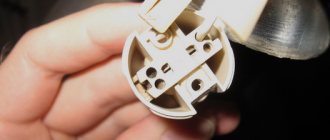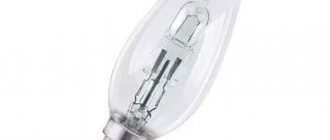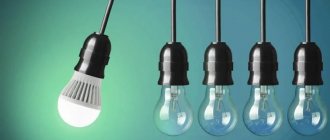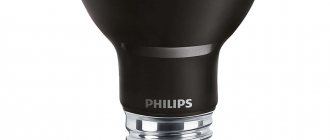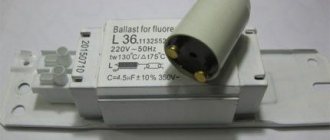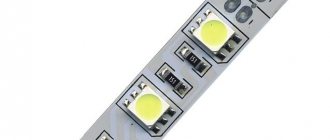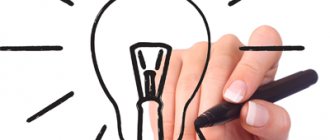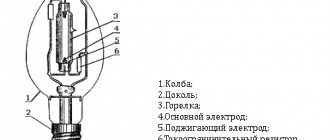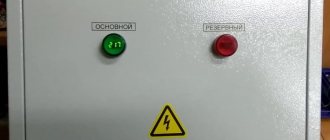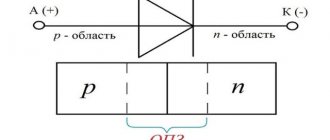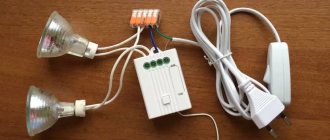Among the huge variety of artificial lighting devices, fluorescent lamps occupy a fairly significant niche. This type of lighting device was first introduced back in 1938, challenging the only monopolists of that time, incandescent light bulbs. Since that time, their design features have undergone significant changes and improvements, due to which fluorescent lamps have become energy-saving. But in order to understand all the pros and cons, and to become more familiar with the features of their use in everyday life and industry, we will study this type of lighting fixtures in detail.
Design and principle of operation
Structurally, fluorescent lamps are a glass bulb, the inner surface of which is coated with a special compound - a phosphor. It consists of calcium halophosphate and other impurities, some versions contain rare earth elements - terbium, europium or cerium, but such combinations are quite expensive.
At the manufacturing stage, all air is pumped out of the flask, and the container is filled with a mixture of inert gases, most often argon, and mercury vapor. Depending on the lamp model, the chemical composition of both inert gases and phosphor will differ. Inside the gas mixture there is a tungsten filament, which is covered with an emitting coating.
Rice. 1. Design and principle of operation of a fluorescent lamp
The principle of operation of such an energy-saving lamp is the following sequence of electrochemical processes:
- A supply voltage is applied to the contacts of a gas-discharge mercury lamp, due to which an electric current begins to flow in the incandescent filament circuit.
- When an electric current flows, thermal energy and emitter particles begin to spread from the surface of the thread, which activate the inert gas and cause the release of ultraviolet radiation.
- The glow of gases has a relatively low percentage of the visible spectrum, since most of it falls on ultraviolet waves. But when the ultraviolet reaches the glass bulb of the gas-discharge lamp, the phosphor is activated and subsequently glows.
The emission spectrum of fluorescent light bulbs can vary over a fairly wide range. The choice of shades of glow in lighting devices is carried out by changing the percentage of magnesium and antimony in the composition of the phosphor.
Also an important point is the temperature indicator, therefore the magnitude of the applied voltage and the flowing electric current must have a constant value for each diameter of the flask. It is strict adherence to the electrical characteristics in relation to its geometric parameters in a fluorescent lamp that allows it to produce the desired color and brightness of the glow.
Common types of such light bulbs
The primary classification of fluorescent-based products is based on the level of base pressure. High pressure devices are used for high power lighting installations and outdoor street lighting.
Low pressure lamps are used in everyday life to supply light to industrial, technical and residential premises for various purposes.
Type #1 - high pressure modules
High-pressure devices produce a rich light flux of good density. The inner surface of the bulb element has a special phosphor coating made of fluorogermanate or magnesium arsenate.
The operating power of such fluorescent lamps ranges from 50-2000 W.
High-pressure mercury modules require a 220-watt nominal mains voltage to operate correctly. Their pulsation coefficient is usually from 61 to 74%
Full ignition of the lighting module occurs within 3 seconds. The service life of 80-125-watt products is about 6,000 hours, and lamps from 400 W or more can work up to 15,000 hours if the operating rules established by the manufacturer are strictly followed.
Type #2 - low pressure products
Low pressure LL is used to provide light flow to residential, technical and industrial premises.
Structurally, the device is a tube made of durable glass containing argon inside at a pressure of 400 Pa and a small amount of mercury or amalgam. It is offered on the market in a wide variety of modifications and is equipped with two electrode elements.
The lowest temperature that low pressure LLs can tolerate is -15 °C. Therefore, these light sources are considered irrelevant for use in open areas.
A glass flask can have a wide variety of diameters. The level of light output varies depending on the power of the device itself. For its correct operation, a throttle-type starter is required. Average service life is 10,000 hours.
Varieties
The entire variety of fluorescent lamps is characterized by a fairly wide range of parameters. But in this article we will look at the most distinctive of them.
In practice, high- and low-pressure lamps are distinguished according to the gas pressure inside the bulb:
- High pressure - such luminescent devices produce a dense light flux in rich color shades. They are used in fairly powerful models with a rating from 50 to 2000 W, characterized by a service life of 6 thousand to 15 thousand hours.
- Low pressure - characterized by a relatively low density of gas in the container, used for lighting premises in the home or in production.
According to the shape of the bulb of an energy-saving light bulb - the bulb can have a classic pear-shaped shape with a glass spiral inside, an oblong elongated shape, the appearance of a spiral tube twisted around an axis, ring-shaped and other shapes.
Rice. 2. Varieties of flask
Based on the design of the base, fluorescent lamps are distinguished with a standard base E with a numerical designation indicating the diameter of the base of the gas-discharge source. G – pin, in which the number after the letter marking shows the distance between the contacts, and before the number of pairs of contacts. You can also find models with W and F type bases, but they are used quite rarely.
Rice. 3. Types of bases
Based on the color temperature of the glow, fluorescent devices with a hot yellow and cold blue spectrum are distinguished. There are also options for neutral glow colors. Color temperatures are selected in accordance with the tasks: warm for housing, cold for industrial facilities.
Rice. 4. Color temperature
Classification and marking of lamps
The marking is applied to the flask itself and metal parts. The ability to decipher the symbols greatly facilitates the selection of the desired light source.
Letter designations correspond to the following indicators:
- L – means fluorescent lamp;
- B – white light;
- D – daylight;
- U is a universal option.
For example, LB corresponds to a white light fluorescent lamp.
Marking the diameter and shape of the flask
The diameter of a glass bulb is designated in inch units in accordance with international standards. The unit of measurement is considered to be 1/8 of it. The size itself is designated by the letter T, and in full it looks like T8, which corresponds to 26 mm, since 8/8 of an inch is one or one whole inch (25.4 mm), which will be almost equal to 26 mm.
Marking
The designation system for fluorescent light bulbs determines their main parameters. However, depending on the country of origin, the designation standards will also differ. For comparison, let’s consider both labeling options using the example of domestic and foreign manufacturers.
Domestic
Domestic marking includes an alphanumeric designation, which includes four positions for letters and one for numbers. For example: LBTSK-60 .
The first letter in the marking L means lamp. The second position is more complex, it can be expressed as one or a pair of letter combinations, it denotes color rendering indices, the following options are possible in it:
- D – daytime spectrum;
- ХБ – cold white glow;
- B – white;
- TB – white warm shades;
- EB – natural spectrum white;
- UV – ultraviolet spectrum;
- G – blue;
- C – blue tint;
- K – red radiation spectrum;
- F - yellow tint
- Z – green.
The third position determines the quality of color rendering, but there are only two options for C - improved quality or CC - especially high quality, which is often used in decorative lighting.
The fourth position indicates the design of the lamp. There are five main positions:
- A – amalgam type;
- B – with quick start;
- K – ring type;
- R – reflector lamps
- U - U shaped.
Foreign
Foreign-made fluorescent lamps have identical marking principles. At the beginning, the power of the product is indicated in watts; it is easily recognized by the Latin letter W.
The type of glow is determined by a digital code with a letter explanation in English:
- 530 is a warm tone of fluorescent lamps, but relatively poor color rendering;
- 640/740 – not quite cold, but close to it with a mediocre level of color rendering;
- 765 – blue tint with a mediocre level of color reproduction;
- 827 – close to an incandescent lamp, but with good color rendition;
- 830 – close to a halogen bulb, with a good level of color rendering;
- 840 – white shade with a good level of color reproduction;
- 865 – daylight spectrum with good color rendering;
- 880 – daylight spectrum with an excellent degree of light transmission;
- 930 – warm tone with excellent color parameters and low light output;
- 940 – cool tone with excellent color rendering and average light output.
- 954/965 – luminescent devices with a continuous spectrum.
The influence of color temperature and light intensity on color perception
It is known from a school physics course that solids, when heated to high temperatures, begin to emit light, the hue of which, depending on the degree of heating, changes from red to dazzling white. This property of the dependence of the color of the emitted glow on the heating intensity was used to characterize artificial light by introducing the “color temperature” parameter. It indicates the value on the Kelvin scale (abbreviated as K) to which a black solid must be heated in order for it to begin to emit white light of that hue.
A person's subjective assessment of light of a certain shade is called color perception. Color temperature affects a person's emotional state and performance. Warm colors relax and create a cozy atmosphere conducive to relaxation. Cold ones invigorate and increase productivity.
Another important parameter is the color rendering index. It shows how the colors of objects are reproduced in a given light compared to sunlight. Depending on the composition of the phosphor used by manufacturers, this indicator for fluorescent lamps can be in the range of 60-98 Ra (out of 100) - the higher, the better color rendering. Devices with this indicator below 80 are used only in utility rooms.
It is necessary to take into account the peculiarities of human color perception, which changes depending on the intensity of light. In low light, warm white light looks more natural. With increasing brightness, cool shades of white are better perceived.
The color temperature of the lamp is selected according to the characteristics of the room:
- in the living room or dining room there is better lighting, as close as possible to daylight and with good color rendition;
- For an office or kitchen, cool white light is preferable - it helps to concentrate on doing the work;
- Warm color tones are suitable for the bedroom, promoting relaxation.
In any case, consider your own preferences, because each person’s color perception is individual.
Specifications
Important technical characteristics for fluorescent lamps are:
- Lamp power - can vary from 10 to 80 W for classic household needs, industrial models can reach 2000 W;
- Rated voltage - in most cases, a voltage of 220V is used;
- Color glow temperature – varies from 2700 to 6500°K;
- Light output - the amount of luminous flux emitted per 1 W of electricity consumed for luminescent devices ranges from 40 to 60 Lm/W, but there are also more efficient models;
- Dimensional parameters – depend on the specific model of the fluorescent lamp;
- Base type – E14 (minion), E27 (standard size), G10 and G13 pin sample and others.
Features of connecting to the network
In view of the difficulties associated with the ionization of the gas gap, several variants of the switching circuit can be used in fluorescent lamps to simplify the ignition of the discharge. The most popular are the electrical circuits of electromagnetic and electronic ballast, which we will consider further.
Electromagnetic ballast
It is the oldest option used in starting fluorescent lamps with cold cathodes.
Rice. 5. Connection diagram with electromagnetic ballast
As you can see, in this circuit the lamp is connected through an electromagnetic inductor and a starter. At the moment the voltage is applied, the starter, consisting of a bimetallic plate, is a circuit with very low resistance, so the current in it increases significantly, but does not reach the short-circuit value due to the inductor. This process triggers an electrical discharge in the fluorescent lamp, and when heated, the starter electrodes open.
Electronic ballast
This connection method involves the use of a special self-oscillator assembled on a transformer and a transistor unit capable of producing a high frequency voltage, which allows for a flicker-free luminous flux.
Rice. 6. Use of electronic ballast
As you can see, a ready-made electronic ballast unit for powering fluorescent lamps is used in accordance with the connection diagram, which is indicated directly on the product body.
Dimensions and efficiency
In order to obtain the maximum effect from an electric discharge, a certain temperature must be maintained in the internal space of the flask. In this case, the ultraviolet radiation of mercury vapor will be greatest. This parameter is directly related to the diameter of the flask. The fact is that the current density in all lamps should be approximately the same. This indicator is determined by dividing the current value by the cross-sectional area of the glass cylinder.
In this regard, lamps with bulbs of the same diameter, but with different wattages, are able to operate at the same rated current. There is a direct proportional relationship between the voltage drop and the length of the cylinder, which determines the energy efficiency class. That is, the longer the lamp, the higher its power, which is clearly reflected in the figure. With a diameter of T5 and 13 t, the length will be 52 cm, 21 watts - 85 cm, 28 watts - 115 cm. The diameter of T8 and a power of 15 watts correspond to a length of 44 cm.
Reasons for failure
Quite often, consumers who are faced with the problem of stopping operation or deterioration of the glow parameters of fluorescent lamps ask themselves the question of finding the causes of the malfunction.
The most common reasons for fluorescent lamps to fail are:
- burnout of the filament - characterized by a complete absence of glow;
- violation of the integrity of the contacts also prevents the lamp from lighting up;
- depressurization of the flask with subsequent release of inert gas - characterized by orange flashes;
- burnout of the starter, breakdown of its capacitor - flickering, inability to start for a long time, a black spot near the contacts;
- a break in the inductor winding or a breakdown on the body - does not turn on or gives alternating on/off during the operation of the fluorescent lamp;
- short circuit in the fluorescent lamp socket or its contacts - characterized by blinking, but without subsequent start-up.
Fluorescent lamp design
Before proceeding with the classification, you should consider the internal structure of the phosphor lamp, which serves as the structural basis for any devices belonging to this category.
These lighting devices are of the gas-discharge type. Fluorescent fluorescent lamps operate on electric current and have an extended service life. They are used in lighting networks of residential buildings, offices and shopping centers, and industrial production facilities. They are produced in various versions, differing in bases, shapes of glass bulbs, color radiation and other parameters.
Despite this diversity, each fluorescent lamp has common design elements. The basis is a glass tube or flask, sealed on both sides. Its length can be different, the inner surface is covered with a special substance - phosphor, and the space is filled with an inert gas, with the addition of a small amount of mercury. Along the edges there are cathodes coated with an active substance. Contact pins brought out are connected to them.
After applying voltage, an electrical discharge is formed between the electrodes. It acts on a mixture of gas and mercury vapor, resulting in ultraviolet radiation. In turn, it affects the phosphor and, interacting with it, turns into visible light. Adjustment of light shades is carried out using phosphors of various chemical compositions.
All these processes are carried out using special ballasts, without which the start-up and operation of a fluorescent lamp is impossible. This equipment is called ballast and is used to regulate electrical discharge.
The ballast can be electromagnetic, with a starter and choke, or electronic, based on a semiconductor circuit. The first option is considered an outdated model; it creates extraneous noise during operation and is large in size. More modern electronic devices are compact, operate quietly, with virtually no noise, and make all switches instantly.
Advantages and disadvantages
Due to fierce competition in the market, fluorescent lighting devices are usually compared with the operating parameters of lamps of a different operating principle.
The advantages of luminescent devices include:
- Sufficiently high efficiency, in comparison with the same incandescent lamps they produce an order of magnitude greater luminous flux for each watt of electricity consumed;
- It has several color spectrum options, which makes their use justified for various purposes;
- The service life before failure is 10–15 times higher than that of incandescent and halogen lamps;
- Quite a wide variety of designs - compact, large, elongated, etc.
However, fluorescent lamps have many disadvantages:
- Much higher cost;
- The presence of mercury, which, when the flask is destroyed, enters the surrounding space;
- Even surviving used lamps require special disposal, which also requires additional costs;
- Stability of operation largely depends on the temperature and humidity of the environment;
- Fluorescent light bulbs cause increased eye fatigue during prolonged reading or eyestrain;
- Compared to LED lamps, there is no risk of mechanical damage;
- Not amenable to classical brightness control methods.
High pressure fluorescent lamps
Low pressure fluorescent lamps Read more: Safety precautions when servicing electric lighting installations
1.3. High pressure fluorescent lamps
High-pressure mercury lamps of the DRL type (mercury arc fluorescent) are produced with a power of 50, 80, 125, 175, 250, 400, 700, 1000 and 2000 W.
A DRL lamp consists of an ellipsoidal glass cylinder (flask), on the inner surface of which is applied a layer of phosphor - magnesium fluorogermanate (or magnesium arsenate). To maintain the stability of the properties of the phosphor, the cylinder is filled with carbon dioxide. Inside the glass cylinder (flask) there is a quartz glass tube filled with mercury vapor under high pressure. When an electrical discharge occurs in the tube, its visible radiation passes through a phosphor layer, which, by absorbing ultraviolet radiation from the quartz discharge tube, turns it into red visible radiation.
The average operating time of DRL lamps ranges from 6,000 hours (lamps with a power of 80 and 125 W) to 10,000 hours (lamps with a power of 400 W or more).
For DRL lamps, the percentage of red radiation is also regulated (6 and 10%). The rated network voltage for all DRL lamps is 220 V. The pulsation coefficient of DRL lamps is 61-74%.
The most modern light sources include metal halide lamps, in which sodium, thallium and indium iodides are added to the mercury discharge in order to increase the luminous efficiency of the lamps. Metal halide lamps of the DRI type (mercury-iodide arc) have ellipsoidal or cylindrical bulbs, inside of which a quartz cylindrical burner is located. Inside this burner, a discharge occurs in vapors of metals and their iodides.
The power of DRI lamps is 250, 400, 700, 1000, 2000 and 3500 W. The luminous efficiency of DRI lamps is 70–95 lm/W.
The luminous efficiency of high-pressure sodium lamps reaches 100-130 lm/W. These lamps have a discharge tube made of floor and crystalline aluminum oxide, inert to sodium vapor and highly transmitting its radiation, placed inside a glass cylindrical flask. The pressure in the tube is about 200 kPa. At this pressure, the sodium resonance lines expand, occupying a certain spectral band, as a result of which the color of the discharge becomes whiter. The operating time of the lamps is 10-15 thousand hours.
To illuminate large areas, powerful (5, 10, 20 and 50 kW) xenon tubular ballastless lamps of the DKsT type are used. They are ignited using a starting device that generates a high-voltage (up to 30 kV) high-frequency voltage pulse, under the influence of which a discharge occurs in the xenon lamp.
Lamps with a power of 5 kW have a nominal voltage of PO V, with a power of 10 kW - a voltage of 220 V, with a power of 20 and 50 kW - a voltage of 380 V. The luminous efficiency of these lamps is from 17.6 to 32 lm / W.
2. Power supply circuits for fluorescent lamps
Fluorescent lamps are connected to the network in series with an inductive reactance (choke), which ensures stabilization of the alternating current in the lamp.
The fact is that an electric discharge in a gas is unstable, when minor voltage fluctuations cause a sharp change in the current in the lamp.
There are the following lamp power supply schemes: pulse ignition, quick ignition, instant ignition.
In the pulse ignition circuit (Fig. 1), the ignition process is provided by a starter (starter). Here, the electrodes are first heated, then an instantaneous voltage pulse occurs. The starter is a miniature gas-discharge light bulb with two electrodes. The bulb bulb is filled with the inert gas neon. One of the starter electrodes is rigid and stationary, and the other is bimetallic, bending when heated. In normal condition, the starter electrodes are open. At the moment the circuit is connected to the network, the full network voltage is applied to the electrodes of the lamp and starter, since there is no current in the lamp circuit and, therefore, the voltage loss in the inductor is zero. The voltage applied to the starter electrodes causes a gas discharge in it, which in turn ensures the passage of a small current (hundredths of an ampere) through both lamp electrodes and the choke. Under the influence of the heat generated by the passing current, the bimetallic plate, bending, short-circuits the starter, as a result of which the current strength in the circuit increases to 0.5-0.6 A and the lamp electrodes quickly heat up. After the starter electrodes close, the gas discharge in it stops, the electrodes cool down and then open. An instantaneous break in the current in the circuit causes the appearance of an electromotive force of self-induction in the inductor in the form of a voltage peak, which leads to the ignition of the lamp, the electrodes of which by that moment are red-hot. After the lamp is lit, the voltage at its terminals is about half the network voltage. The rest of the voltage is extinguished at the inductor. The voltage applied to the starter (half the mains voltage) turns out to be insufficient to trigger it again.
Rice. 1. Pulse circuit for connecting a fluorescent lamp to the network:
1 – starter (starter); 2 – lamp; 3 – throttle.
In the fast ignition circuit (Fig. 2), the electrodes of the lamps are connected to separate windings of a special incandescent transformer. When voltage is applied to a non-burning lamp, the voltage loss in the inductor will be small, the increase in voltage of the filament windings is completely applied to the electrodes, which quickly and strongly heat up, and the lamp can light up at normal mains voltage. When a discharge occurs in the lamp, the filament current of the ballast automatically decreases.
Rice. 2. Scheme for fast ignition of a fluorescent lamp:
1 – throttle; 2 – lamp; 3 – filament transformer.
The instant ignition circuit (Fig. 3) uses a choke-transformer and a separate resonant circuit, which creates an increased (6-7 times more than the operating) voltage on the lamp at the moment of switching on. Instant ignition circuits are used only in certain cases, for example in explosive areas with lamps containing special reinforced electrodes. Electrodes of normal type lamps in the circuit shown in Fig. 3, wear out quickly. The high voltage supplied to the lamp at the initial moment poses a danger to operating personnel.
Rice. 3. Diagram of instant ignition of a fluorescent lamp
1 – lamp; 2 – capacitor; 3 – choke-transformer.
When the throttles operate, noise occurs. To provide the required current and voltage at the lamp terminals in starting and operating modes, increase the power factor, reduce the stroboscopic effect and reduce the level of radio interference, special ballasts are attached to fluorescent lamps. The ballasts include chokes, capacitors (to increase the power factor and suppress radio interference) and resistors, placed in a common metal casing and filled with bitumen mass.
According to the ignition method, ballasts are divided into three groups: starter (symbol UB), fast and instant ignition (symbol AB).
The main types of ballasts for fluorescent lamps: 1UBI-40/220-VP-600U4 or 2UBI-20/220-VPP-110HL4, which means the following: the first digit indicates how many lamps are switched on with the device; UB—starter control gear; I - inductive phase shift of the current consumed by the device (can be E - capacitive or K - compensated, i.e. compensating the stroboscopic effect); 40 and 20 — lamp power, W; 220 — supply voltage, V; B - built-in device (maybe N - independent); P - with reduced noise level; PP - with particularly low noise level; 600 and software - series number or modification of the ballast; U and HL - the ballast is designed for operation in areas with a temperate or cold climate, respectively (it can also be TV - tropical humid climate; TC - tropical dry climate; T - tropical wet and dry; 0 - any climate on land); 4 - placement in rooms with an artificially controlled climate (maybe 1 - in the open air; 2 - rooms poorly insulated from the surrounding air, and canopies; 3 - ordinary naturally ventilated rooms; 5 - rooms with high humidity and unventilated underground rooms).
Ballasts for arc mercury fluorescent lamps (MAFL), arc mercury iodide lamps (MAI), high-pressure sodium lamps (HPL) are designated as follows: 1DBI-400DRL/220-N or 1DBI-400DNaT/220-V. Here DB is a ballast choke; DRL and DNaT - type of lamp (DNaT means the same as NLVD); N - independent ballast.
The electrical diagram of starter two-lamp ballasts is shown in Fig. 4.
Rice. 4. Electrical diagram of starter ballast 2 UBI for two lamps
1 – throttle; 2 – lamps; 3 – starters.
Ballasts for arc mercury fluorescent lamps of the DRL type are made with a choke (Fig. 5).
Fig.5. Scheme for switching on DRL type lamps through a choke.
1 – throttle; 2 – lamp; C – capacitor.
To turn on DRI and HPS lamps, ballasts with standardized pulse ignition devices are used, the main elements of which are diode thyristors (Fig. 6). Here, however, restarting a lamp that has gone out and is not equipped with a special instant re-ignition unit is possible only after it has cooled, i.e. after 10-15 minutes.
Fig. 6 Connection diagram for lamps of the DRI or HPS type.
1 – pulse ignition device; 2 – ballast choke
3. Basic lighting quantities
The amount of light emitted by a source is called luminous flux and is denoted by F. The unit of luminous flux is lumen (lm).
The luminous flux contained within a solid angle q, at the vertex of which a point light source of force J is located, is determined by the formula Ф = Jq.
Luminous intensity J is the density of luminous flux in one direction or another; measured in candelas (cd).
Candela is the luminous intensity emitted from an area of 1/600,000 m2 of the cross-section of a full emitter in a direction perpendicular to this cross-section, at an emitter temperature equal to the solidification temperature of platinum (2045 K) and a pressure of 101,325 Pa.
The solid angle b is equal to the ratio of the surface area o, cut out on a sphere by a cone with its vertex at point S, to the square of radius r (Fig. 2.1). If r = 1, then the solid angle is numerically equal to the surface area cut out by a cone on a sphere of unit radius. The unit of solid angle is the steradian (sr).
Thus, a lumen is the product of a candela and a steradian. The illumination of the working surface will be better, the greater the luminous flux falling on this surface. The degree of surface illumination, i.e., the density of the luminous flux onto the illuminated surface, is characterized by illumination E, which is measured in lux (lx). If a luminous flux equal to 1 lm falls on 1 m2 of any surface, then the illumination E will be 1 lux, i.e. lm/m2.
When the working surface is illuminated, light and dark details stand out in it, differing in their brightness I., which depends not only on the illumination, but also on the reflective properties of the surface. Brightness determines the sensation of light received by the eyes. If the brightness of the surface is very low, it is difficult to discern details on it, and vice versa, if the brightness is very high, then the surface will blind the eyes. Brightness is equal to the ratio of luminous intensity to the projection area of a reflecting (emitting) body in a given direction; measured in candelas per square meter (cd/m2).
Low pressure fluorescent lamps Read more: Safety precautions when servicing electric lighting installations
Information about the work “Electric light sources”
Section: Physics Number of characters with spaces: 40244 Number of tables: 0 Number of images: 6
Similar works
History of the development of light sources
16247
1
0
... the fabric burned, leaving a thin “skeleton” that glowed brightly when heated by the flame. These devices are called Auer caps. In principle, this is where the history of the development of lamps using chemical energy as an energy source practically ceased, although gas lighting competed with electric lighting for a long time (See the film “Gas Light”). The appearance of acetylene (...
Optical radiation sources
30079
0
9
... there is no sound to the piano string. Like a string that begins to sound only after being struck by a hammer, atoms give birth to light only after they are excited. 1. Radiation sources 1.1 Types of radiation sources. Principles of their classification An optical radiation source is a device that converts any type of energy into the energy of electromagnetic radiation in the optical range of the spectrum. In lighting engineering for...
History of the invention and development of electric lighting
16328
0
0
...at the theater in 1847, during the performance (they were performing Meyerbeer’s opera “The Prophet”), the sunrise was simulated using an arc lamp! The further history of electric arc lighting is associated with the inventions of various mechanical and electromagnetic regulators. The idea of Chikolev’s differential regulator, which was widely used in floodlight manufacturing, was used by other designers, in ...
Development of an automatic light control device on a microcontroller
155474
21
15
... 4.5 - 5.5 V (ATmega16) * Operating frequency 0 - 8 MHz (ATmega16L) 0 - 16 MHz (ATmega16) Figure 1.4 - Functional diagram of the ATMega 16L microcontroller SECTION 2 DEVELOPMENT OF AN AUTOMATIC LIGHT CONTROL DEVICE Despite the rapid development of super-bright LEDs , LED lamps capable of replacing household incandescent lamps have not yet become widely available. Those who received...
Application area
The list of areas in which fluorescent lamps can be installed is quite large. Most often you can find them in domestic premises or offices as the main lighting. In stores or shopping centers they are installed as lighting devices for display cases, walls and other interior elements and can easily replace a neon light bulb. They can often be found illuminating corridors and large rooms with elongated tubular fluorescent lamps.
In the industrial sector, they are often used as lamps for floodlighting, which covers a large area. Spotlight fluorescent devices have excellent light transmission, despite the height distance from the illuminated surface.
Household and office lamps
In domestic or industrial premises, devices that are characterized by the absence of excessive decorative excesses are most often used.
At the same time, they provide maximum energy flow, which creates favorable conditions for performing professional duties.
When considering office lamps, it is necessary to pay attention to the fact that their varieties necessarily depend on the size of the area that needs to be illuminated, as well as on the possibility of ensuring proper aesthetic design.
